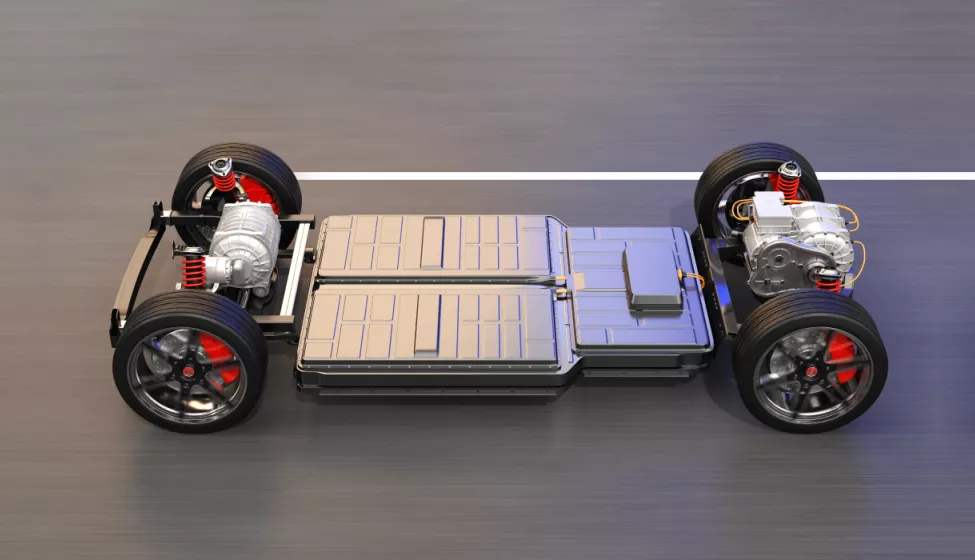April 15, 2021
The rapidly growing global electric vehicle (EV) market is projected to reach $802.8 billion by 2027. Powered by batteries and high-voltage electronics, EVs tend to have lower operating and maintenance costs than conventional vehicles and produce little to no air pollution. Unfortunately, the complex design of EV structures and their high operating voltages can contribute to new risks of occupant and first responder injury in the event of a collision.
By evaluating battery pack crashworthiness and designing EVs for structural performance, manufacturers can help protect vehicle occupants and optimize the viability of their technology.
Impact-Induced Electric Vehicle Damage Assessment
EVs are loaded with high-voltage battery packs, circuitry, control modules, inverters, and other electronics that can potentially catch fire due to crash damage. A crash can cause leaking battery cells, short circuits, and damaged insulation between battery cells and the walls of the metal containers in which the cells are stacked. This may result in a rapid rise in cell temperatures leading to thermal runaway and potentially large loss fires.
Most EV fires in recent years appear to have been caused by mechanical penetration or a structurally compromised vehicle battery.
While many documented crashes have occurred at typical highway speeds, it is important to note that impacts at lower speeds (e.g., situations involving road debris piercing the vehicle underbody) may also result in battery pack intrusion depending on the impact location and proximity to the battery enclosure.
The details of each particular crash scenario must be analyzed to understand the circumstances of the crash, the crash severity, and other factors contributing to the potential compromise of the structural integrity of the vehicle battery. This requires thorough evidence gathering, detailed inspections, and the application of accident reconstruction methods. The involved vehicles are inspected for damage, which can include inspection of the battery enclosure for structural damage and the battery cells and other electronics for deformation or thermal damage. The crash site layout is measured and inspected for evidence. Incident data is collected, which may be stored in a vehicle event data recorder (EDR), may be found in the crash environment as security camera footage or traffic signal data, or may come from police reports or witness statements.
Designing Electric Vehicles for Structural Performance
EV manufacturers are increasingly challenged to optimize drive range while maintaining a lightweight design. Once charged, EVs are typically expected to offer a range of 200 or more miles, requiring at least 70-80 kW-h of electrical energy. Battery systems of this caliber can typically weigh 500 kg or more. While increasing battery range and decreasing vehicle weight appear to be conflicting goals, it is possible to design the protective structure surrounding the battery pack through structural optimization within the vehicle structure.
Manufacturers are exploring collapsible, multi-functional battery pack structures to achieve an optimal drive range/vehicle weight balance. By replacing traditional structures in the chassis with energy-absorbing battery pack components and enclosures, manufacturers can manage the weight requirements of the vehicle and improve its efficiency and range. The battery pack enclosure is intended to be part of the load path in crash events; therefore, it is critical that the design of the enclosure not adversely affect the vehicle crashworthiness or increase the potential for battery damage or injury to the vehicle occupants in a collision.
Traditionally, designers have avoided placing the battery pack near the front of a vehicle. The front of the vehicle is dedicated to energy dissipation and load path management for frontal impact safety, the most common collision mode in vehicle crashes. Therefore, battery packs have not been typically designed to be structural components. More recently, however, vehicle manufacturers are now considering structural engagement of the battery pack as a component of energy dissipation during frontal and oblique impacts.
Our team at Exponent can assist by conducting simulations and testing to evaluate battery pack and enclosure designs and placement in a variety of impact scenarios to help meet overall goals of improving vehicle performance and durability and occupant protection in different crash modes.
Evaluating Electric Vehicle Crashworthiness and Structural Performance
Safety precautions for EVs span well beyond the National Highway Traffic Safety Administration's (NHTSA) Federal Motor Vehicle Safety Standards (FMVSS). Over the years, testing has evolved to include post-crash checks for isolation of high voltage from the chassis, leakage of volatile gases, and physical damage of systems.
The Society of Automotive Engineers (SAE), the United Nations Economic Commission for Europe, and draft Global Technical Regulation No.13 for Rechargeable Energy Storage Systems (RESS) prescribe tests that evaluate vehicle response to vibration, thermal shock and cycling, over- and under-charge protection, and other environmental, mechanical, and electrical conditions to which EVs may be exposed while on the road.
Simulated and real-world vehicle testing can help manufacturers evaluate the crashworthiness and mechanical performance of new vehicle designs. Our multi-disciplinary team at Exponent frequently helps manufacturers understand and evaluate the effects resulting from batteries compromised by intrusion or subjected to other failure modes.
By performing failure mode and effects analysis (FMEA) of battery protection systems and finite element analysis (FEA) of the battery pack, we can help manufacturers predict and assess design crashworthiness. This can help reduce the costs of crash-testing prototype vehicles or lead times associated with concept-to-production builds.
At our Test & Engineering Center, we can also perform a wide spectrum of testing, ranging from full-charge crash tests and component-level testing for battery packs to battery cell level analysis. Exponent offers state-of-the-art testing capabilities and numerical simulation for manufacturers seeking to understand impact scenarios at both the component and system level.
How Exponent Can Help
Exponent's multidisciplinary team of mechanical, vehicle, and electrical engineers offers deep expertise in structural evaluation, crashworthiness, and battery failure mode analysis to help automotive manufacturers design and test complex EV structures for optimal protection of occupants and energy sources.

